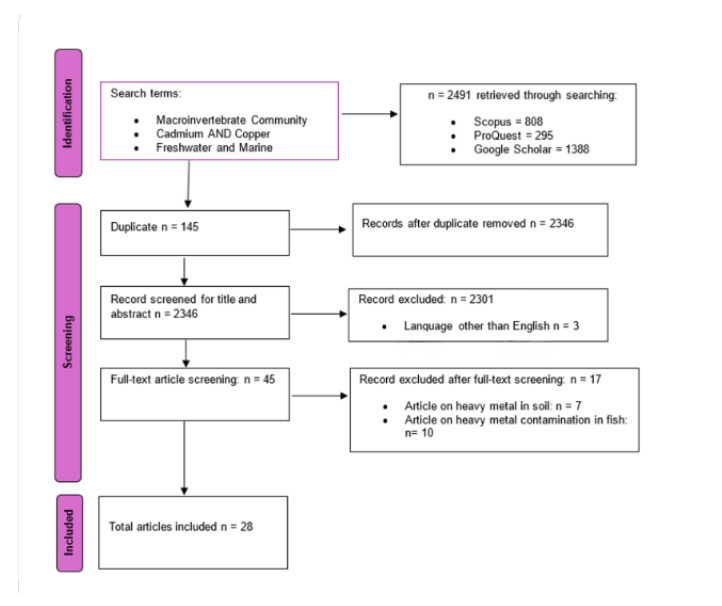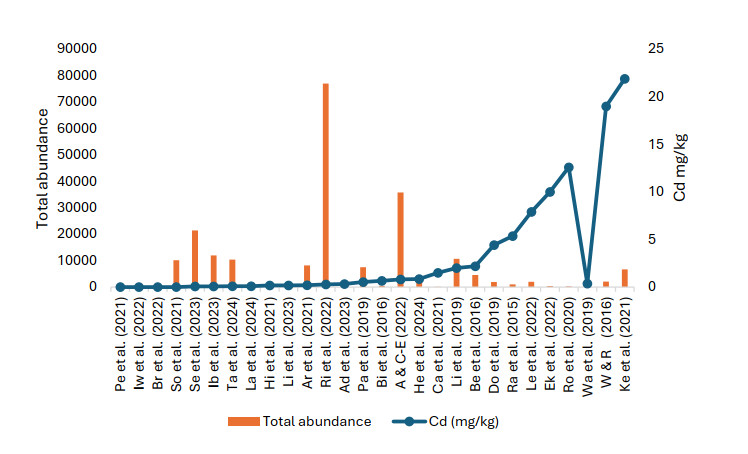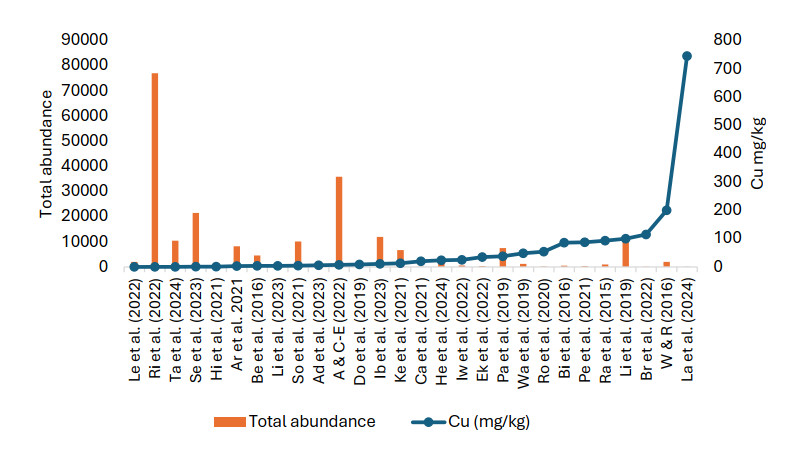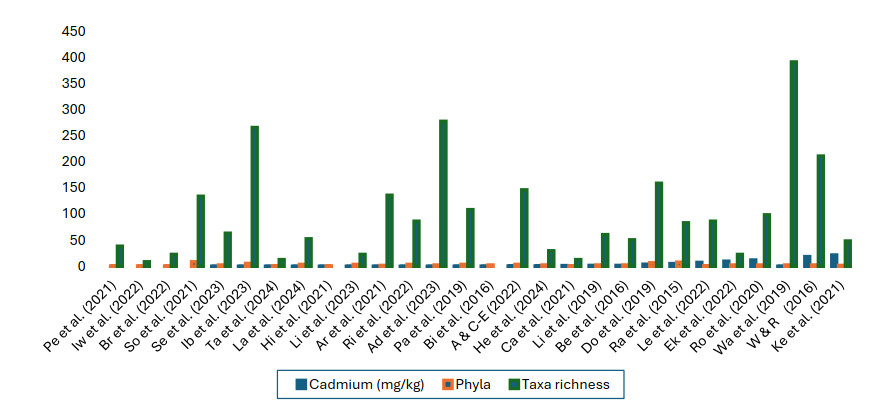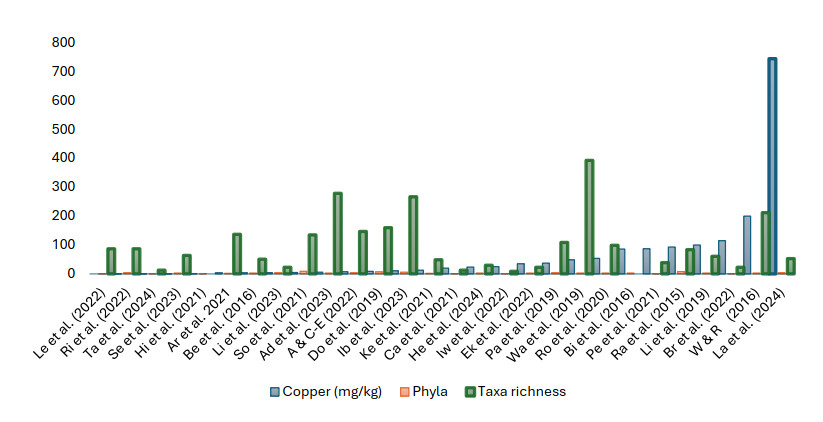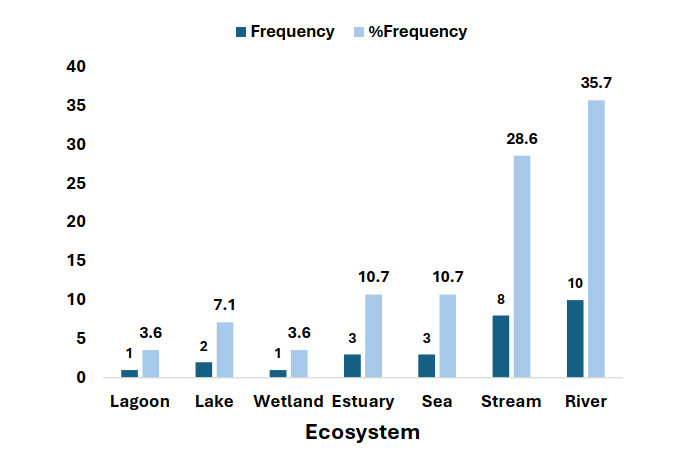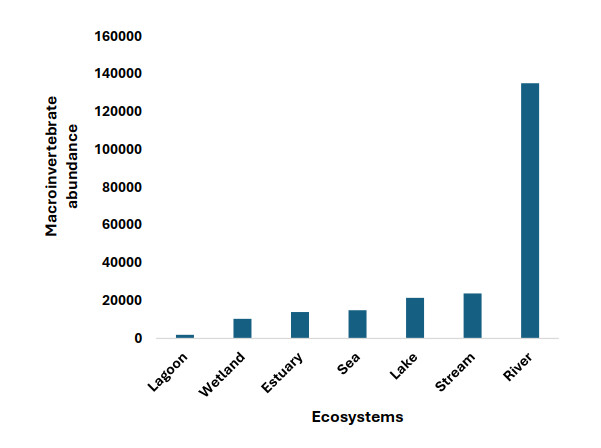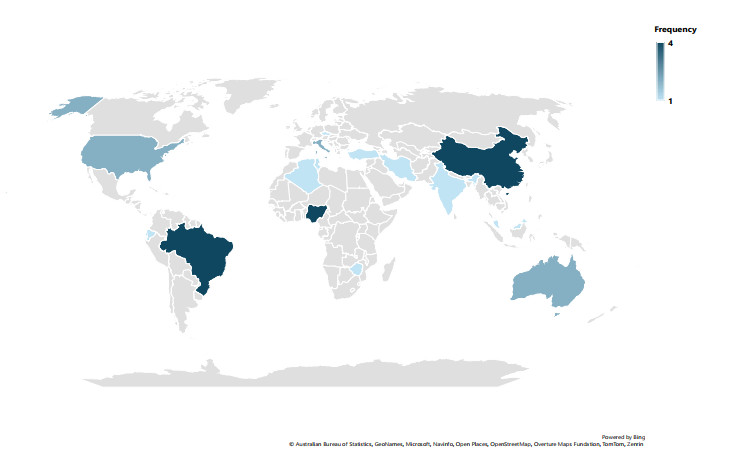1.
Introduction
Aquatic ecosystems play a vital role in biodiversity and ecosystem functioning, offering essential services such as water filtration, nutrient cycling, and habitat provision for aquatic species [1]. However, they are among the most vulnerable environments to heavy metal contamination, which poses a significant threat to biodiversity and ecological balance [2]. Heavy metals such as cadmium (Cd) and copper (Cu) are particularly concerning due to their persistence, toxicity, and ability to bioaccumulate in aquatic organisms [3,4]. These metals enter water bodies through anthropogenic activities, including industrial discharges, agricultural runoff, and urban wastewater, leading to widespread contamination [5]
Macroinvertebrates, a diverse group of organisms that include species such as insects, mollusks, and crustaceans, possess varying sensitivities to contaminants, are crucial components of these systems[6], and are widely used to assess the ecological impacts of metal contamination in aquatic environments [7]. Their abundance and diversity are critical for maintaining ecosystem functions, such as nutrient cycling, sediment stability, and serving as a food source for higher trophic levels [2,8]. However, the increasing influx of heavy metals has raised concerns about their impact on these vital organisms [9], as even low concentrations can disrupt physiological processes and alter community structures [10]. Understanding the relationship between heavy metal contamination and macroinvertebrate communities is essential for developing effective conservation strategies and mitigating the adverse effects of pollution on aquatic ecosystems [11]. Given their sensitivity to pollution, especially heavy metal contamination, the study of macroinvertebrate communities provides valuable insights into the overall health of aquatic ecosystems [12,13].
Research shows that macroinvertebrates, highly sensitive to changes in water and sediment quality, often experience reduced diversity in regions with elevated heavy metal concentrations [14]. These metals, primarily introduced through industrial discharges, agricultural runoff, and mining activities, disrupt the structure and function of ecosystems [15] by limiting sensitive taxa and promoting the dominance of pollution-tolerant species, resulting in altered community dynamics [16]. Heavy metals like Cd and Cu are particularly concerning due to their toxicity, persistence, and ability to bioaccumulate, which negatively impacts the growth, reproduction, and survival of aquatic invertebrates [17,18]. Even at low concentrations, cadmium poses significant threats to aquatic organisms, causing both lethal and sub-lethal effects in macroinvertebrates. Similarly, although copper is an essential trace element, elevated levels can become toxic, interfering with ion regulation and disrupting metabolic processes [19]. Despite these differences, both metals cause significant changes in macroinvertebrate community compositions, reduce biodiversity, and diminish the effectiveness of ecosystem services in polluted aquatic environments. These shifts in macroinvertebrate assemblages not only indicate water quality degradation but also point to larger ecological disruptions, such as changes in energy flow and nutrient cycling within these ecosystems [19].
The researchers [20] analyzed global heavy metal pollution in rivers and lakes (1970–2017), finding higher contamination in Asian rivers than in Europe, primarily from mining and manufacturing. Increasing levels of Cd, Mn, Cu, Fe, Ni, and Cr were identified, with Cd and Cu significantly impacting aquatic ecosystems by disrupting key processes [21]. These processes led to disruptions in energy and trophic interactions, diminishing their role in maintaining an ecosystem balance [22,23]. Elevated heavy metal levels in sediments are a major concern due to their toxicity, persistence, and bioaccumulation [24]. Sediments act as significant sinks, often containing metal concentrations far exceeding those in water [25]. The researchers [17] found negative correlations between sediment metal concentrations and macroinvertebrate diversity, highlighting the detrimental impact of metal contamination on aquatic ecosystems. Additionally, the researchers [26] found that elevated Cd and Cu levels from shale drainage significantly reduced the abundance and diversity of metal-sensitive macroinvertebrates, such as Heptageniidae and Chloroperlidae. However, stringent effluent standards, improved waste treatment, and sustainable farming can greatly reduce aquatic metal contamination.
Cadmium and copper holds particular importance because these metals rank among the most widespread and ecologically disruptive pollutants in aquatic systems. Focusing on these metals provides a more detailed understanding of their ecological consequences, which are often underestimated in broader studies that address heavy metals collectively [27]. Furthermore, we explore the influence of Cd and Cu on the structure and diversity of macroinvertebrate communities. We seek to uncover ecological disruption patterns, such as declines in species richness and a shift toward communities dominated by pollution-tolerant species. Additionally, we examine how these changes undermine ecosystem functionality [28,29].
Reviews encompassing the influence of heavy metal contamination, particularly cadmium and copper, have predominantly addressed broader aspects of water quality or specific ecological concerns, such as bioaccumulation and toxicity thresholds in aquatic organisms [30]. In contrast, we narrow the scope to macroinvertebrate assemblages as key ecological indicators, synthesizing insights from field studies to offer a comprehensive perspective on community-level impacts of heavy metals [31]. This approach advances prior research by integrating evidence from diverse studies to identify consistent patterns in biodiversity loss, alterations in community structure, and disruptions in ecosystem functioning [32,33]. Ultimately, it offers a more precise framework for environmental monitoring and conservation efforts.
This review advances our knowledge by systematically synthesizing research on the influence of cadmium and copper contamination on aquatic ecosystems, with a focus on macroinvertebrate community structure. It offers a thorough analysis of how these heavy metals influence biodiversity, alter species composition, and disrupt ecosystem functioning, drawing on findings from studies and geographic regions [34]. By consolidating these insights, it lays a robust scientific groundwork for policymakers and conservationists to design effective strategies aimed at mitigating heavy metal pollution in aquatic ecosystems. Therefore, our objective of this study is: 1. To examine macroinvertebrate abundance and diversity in response to Cd and Cu contamination across studies. 2. Assess the relationship between metal contamination, macroinvertebrate community composition, and species richness. 3. Investigate the relationship between heavy metal contamination in different ecosystem types and macroinvertebrate diversity.
2.
Materials and methods
2.1. Inclusion and exclusion criteria
We prioritized the selection of high-quality and relevant research, focusing on peer-reviewed journal articles. To capture a wider range of perspectives, conference papers presenting related studies were also included. However, literature reviews, book chapters, meta-analyses, news articles, and monographs were deliberately excluded to maintain the emphasis on original research findings and uphold the integrity of the review process. The scope of the review was intentionally narrowed to include studies only directly aligned with its objectives, ensuring that the synthesized evidence was both meaningful and directly addressed the key research questions. No date restrictions were applied, enabling the inclusion of all articles published up to 2024. This comprehensive approach facilitated a thorough overview of developments in all fields, providing a detailed understanding of the progression and current state of the subject matter.
2.2. Literature search
We conducted a systematic search for articles examining the relationship between Cd and Cu and the community structure of macroinvertebrate assemblages in aquatic ecosystems worldwide. Relevant data were collected from published sources using Scopus, ProQuest, and Google Scholar databases. Specific search terms, combined with Boolean operators ("AND" or "OR"), were utilized, as outlined in Table 1. This method facilitated the identification and organization of literature related to how Cd and Cu contamination in aquatic environments affect macroinvertebrate abundance and diversity.
2.3. Article screening and data extraction
The search for articles from each database was conducted at two separate times using the same methods to minimize errors. The first search, which began on November 3, 2024, was completed on November 15, and the second search, conducted as a confirmation search, was finished on December 23, 2024 [35]. Any new papers identified in the second search were carefully reviewed by assessing their abstracts and full texts before being added to the collection. The PICO (Population, Intervention, Comparator, and Outcome) framework was applied to define themes, keywords, and synonyms relevant to the use and impact of artificial intelligence on employability. A summary of these elements is provided in Table 1. We used several databases for our research, including Google Scholar (https://scholar.google.com/), ProQuest (https://www.proquest.com/), and Scopus (https://www.scopus.com/). Additionally, we employed a snowballing technique by reviewing the reference lists of the most relevant articles collected from these databases [36].
After a thorough screening using Microsoft Excel for data extraction, articles that met the inclusion criteria were selected for the analysis. Data from these articles, which included the Cd and Cu concentrations, macroinvertebrate abundance, taxa richness, types of ecosystems, phylum, class, number of phyla and class, duration of study, and geographical location, were extracted.
3.
Results and discussion
3.1. Search result
We targeted the relationship between Cd and Cu contamination of aquatic ecosystems and the community structure of macroinvertebrate assemblages worldwide, resulting in 2491 articles retrieved from the three online databases (Figure 1). After removing 145 duplicates, 2,301 articles were excluded during title and abstract screening. A thorough examination of the remaining 45 studies at the manuscript level led to selecting 28 studies that met the inclusion criteria according to PRISMA guidelines.
The outcome of our systematic search reflects the growing interest within the scientific community in the contamination of aquatic ecosystems by cadmium and copper, as well as their broader environmental and ecological effects. cadmium and copper contamination in aquatic environments has led to a drastic decline in macroinvertebrate populations, with significant reductions in species richness or diversity and increased accumulation of metals [37]. This underscores the vital role macroinvertebrates serve as bioindicators for evaluating the ecological effects of metal pollution in these environments. cadmium and copper are major contributors to pollution in freshwater and marine ecosystems, greatly affecting aquatic macroinvertebrates. These organisms play a crucial role in maintaining the health of the aquatic ecosystem and are particularly vulnerable to contamination by heavy metals. Both Cd and Cu accumulate in macroinvertebrate tissues, causing disruptions to their physiological processes, decreasing biodiversity, and altering the composition of their communities[38]. Elevated levels of cadmium have been strongly associated with declines in macrobenthic populations and are often considered among the most harmful pollutants. cadmium is particularly noteworthy as a heavy metal that can lead to changes in the functional traits of macroinvertebrate communities [39]. According to the researchers [40], there is increasing scientific interest in the effects of Cd and Cu on macroinvertebrate abundance and diversity due to their significant environmental and ecological implications.
As pointed out by Affengruber L et al. [41], the thorough screening process of articles highlights the importance of incorporating only relevant and credible sources in this study. The selected articles adhered to the inclusion criteria and provided essential insights into trends, methodologies, and the broader implications for understanding how Cd and Cu affect macroinvertebrate assemblages (MIA) in aquatic ecosystems globally. Table 2 offers a concise overview of the data drawn from the 28 selected studies.
3.2. Macroinvertebrate abundance and heavy metal contamination
Cadmium (Cd) concentrations show considerable variation across ecosystems, influenced by pollution sources, environmental conditions, and the type of aquatic habitat [70]. cadmium is a toxic heavy metal, even at low concentrations, and its presence in aquatic ecosystems poses serious ecological risks, particularly to sensitive species [71,72]. According to a cited source [73], a Cd value ≤ 0.1 mg/kg indicates low Cd, while values between 0.1–2.5 mg/kg indicate moderate Cd concentration, and values > 2.5 mg/kg indicate a high Cd concentration. High values of Cd are extremely toxic to aquatic life, often causing sensitive species to be eliminated from contaminated areas [74,75]. This leads to a decline in overall abundance and species diversity [76]. Ecosystems exposed to elevated Cd levels tend to become dominated by pollution-tolerant species, while sensitive organisms like certain aquatic insects and mollusks are lost [77,78]. At low Cd concentrations, the impact on aquatic life is less severe. Sensitive species such as aquatic insects (Ephemeroptera, Plecoptera, Trichoptera) can survive, maintaining relatively high biodiversity and macroinvertebrate abundance. However, bioaccumulation can occur over time, particularly in mollusks and crustaceans [79], which filter water or reside in sediments where Cd tends to accumulate [26].
The comparison of Cd concentration values and total abundance across the selected studies are shown in Figure 2. These values range from 0.001mg/kg to 21.90 mg/kg across aquatic environments in the selected studies.
In Figure 3, Insecta emerges as the most dominant class, with a frequency of 23, highlighting its ecological prominence or abundance in the aquatic ecosystems, while Turbellaria shows the lowest frequency of 5, potentially indicating its lower prevalence or limited representation in existing literature. However, moderate frequencies are recorded for Bivalvia, Oligochaete, Polychaeta, Clitellate, Crustacea, and Hirudinea [80,81].
The wide range of Cd levels could indicate varying degrees of pollution in different parts of the ecosystems. The presence of Insecta, which tend to be more pollution-tolerant compared to other taxa like mollusks, suggests that higher Cd levels may be limiting diversity in these ecosystems, particularly by excluding more sensitive species [82]. With higher Cd concentrations than the previous study, this ecosystem supports a rich diversity of macroinvertebrate classes. Furthermore, it is likely that the more pollution-tolerant groups (e.g., Oligochaeta, Hirudinea, and Bivalvia) are more abundant, while the presence of more sensitive classes like Insecta suggests a threshold where they can survive but might be less dominant [83]. However, moderately elevated Cd concentration supports a variety of macroinvertebrate classes, suggesting that this level of Cd contamination does not eliminate sensitive classes like Insecta and Gastropoda but may promote tolerance in certain resilient groups like Oligochaeta and Polychaeta, which are often found in more polluted environments [84]. Furthermore, the low Cd range correlates with the dominance of Insecta, a class generally considered sensitive to heavy metal pollution. This low level of contamination likely supports a less polluted ecosystem where more sensitive species can flourish without being outcompeted by those that are more tolerant to pollution [85,86]. Therefore, the variation in macroinvertebrate assemblages with differing Cd levels highlights the significant impact of metal pollution on the composition and structure of aquatic communities. The comparison of Cu concentration values and total abundance across the selected studies is shown in Figure 4. These values range from 0.001mg/kg to 745.0 mg/kg across aquatic environments and the selected studies.
The relationship between copper concentration and macroinvertebrate abundance highlights a troubling trend, suggesting that elevated levels of copper could negatively impact abundance, resulting in a decline in macroinvertebrate populations [87,88]. This phenomenon is consistently observed across studies, underscoring the harmful effects that elevated copper concentrations can have on aquatic ecosystems [89,90]. Furthermore, some researchers, such as Arnold A et al. [91] found no significant differences in macroinvertebrate abundance between treated and untreated areas, implying that factors like bioavailability and other environmental conditions might mitigate the impact of Cu contamination. This emphasizes the complexity of ecological responses to copper pollution. Conversely, lower concentrations of Cu generally promote greater macroinvertebrate abundance, although other environmental factors, such as sediment quality and water chemistry, are also crucial in shaping these communities [92]. Cu levels below 1mg/kg are linked to high macroinvertebrate abundance, suggesting that low copper levels can benefit the ecosystems. Moderate Cu concentrations (3-30 mg/kg) support moderate to high abundance, indicating that this range may be ideal for sustaining healthy populations. However, when copper concentrations exceed 60mg/kg, there is a noticeable decline in macroinvertebrate abundance and biodiversity, implying that higher copper levels may adversely affect these communities [93]. Lower concentrations of Cd and Cu have been linked to increased abundance and diversity of macroinvertebrate species when compared to sites exhibiting relatively elevated levels of these heavy metals. While low levels of heavy metals can foster diverse macroinvertebrate communities, it is essential to acknowledge that other human-related stressors may harm these ecosystems.
Here, we examine the intricate relationship between heavy metal contamination, specifically Cd and Cu and macroinvertebrate abundance in aquatic ecosystems. The variations in Cd and Cu concentrations observed across studies reflects differing degrees of human-induced pollution, which influence macroinvertebrate community composition and diversity. Elevated levels of these metals favor pollution-tolerant species while diminishing populations of more sensitive taxa, leading to biodiversity loss. Conversely, ecosystems with lower contamination levels generally support a richer diversity of species, though the threat of bioaccumulation remains a significant concern [94]. These findings highlight the profound impact of heavy metal contamination on macroinvertebrate communities, particularly regarding species abundance and diversity. In the future, researchers should take a more integrative approach by considering multiple environmental stressors to gain a deeper understanding of their combined effects on aquatic ecosystems. Furthermore, the urgent need for pollution mitigation strategies is highlighted, emphasizing the importance of continued research into the long-term ecological consequences of heavy metal exposure.
3.3. Heavy metal contamination, macroinvertebrate diversity, and taxa richness
Cadmium is typically detected at relatively low concentrations (0.001 mg/kg) across most studies. However, there are occasional spikes, suggesting elevated levels of Cd in a limited number of studies. In contrast, Cu shows marked variability, with some studies reporting extremely high concentration levels. Nevertheless, low levels of Cd (0.001 mg/kg) and Cu (0.001 mg/kg) were associated with significantly higher macroinvertebrate abundance, with over 77,000 individuals recorded in such conditions. Conversely, at extreme heavy metal concentrations, the abundance of macroinvertebrates declined sharply, with as few as 22 individuals recorded as the highest Cu levels (745mg/kg). These findings support the hypothesis that even moderate concentrations of heavy metals exert harmful effects on aquatic biota, interfering with physiological and metabolic processes required for their survival [95]. This variation suggests that Cu contamination levels are quite inconsistent across the selected studies [96,97]. Phyla count shows little variation across studies, with each maintaining a low and stable value [98]. This consistency suggests that the diversity in terms of higher taxonomic levels (phyla) is not significantly impacted by metal concentrations or remains relatively low across environments [99]. Taxa richness varies considerably between studies, with some studies showing very high richness values (393) while others remain low (9) [100]. Studies with high Cu concentrations often show a decrease in taxa richness. This trend might suggest that elevated Cu levels are detrimental to biodiversity, especially at finer taxonomic levels like species [101]. While phyla remain stable, the sharp fluctuations in taxa richness indicate that species-level diversity is more sensitive to environmental stressors, potentially from metal contamination, compared to broader taxonomic levels [102]. The relationship between cadmium concentration and macroinvertebrate diversity appears to be weak, as evidenced by studies indicating that low levels of Cd may not significantly impact biodiversity metrics. This suggests that within the observed concentration range, Cd's effects on macroinvertebrate communities are minimal [103]. Cu contamination seems to have a more noticeable impact on species abundance and diversity than Cd within these studies. Taxa richness (species-level diversity) is particularly sensitive to metal contamination, with high Cu concentrations often aligning with lower diversity values [104]. Phyla, however, remain stable across varying metal concentrations, suggesting resilience at these higher taxonomic levels.
The number of instances of macroinvertebrate classes across the selected studies indicates that the class Insecta was the most frequently studied macroinvertebrate group, appearing in 23 of 28 studies, emphasizing its ecological importance and prevalence in the ecosystems examined [105,106]. Their diverse feeding strategies are essential in nutrient cycling and energy transfer within these ecosystems [107]. Although groups such as Bivalvia (11), Gastropoda (18), and Malacostraca (13) were only moderately represented, they played vital roles, especially in filtration and substrate stabilization [108,109]. Several classes, such as Branchiopoda (2), Copepoda (1), and Arachnida (2), were represented in a few studies, indicating their presence in more specialized or restricted habitats [110]. Furthermore, factors such as water quality, habitat structure, and human activities have a profound influence on macroinvertebrate assemblages [111,112]. Since they are highly responsive to changes in their environment, these organisms act as reliable indicators for assessing the overall health of ecosystems [113]. Taxa richness, representing the diversity of taxa (commonly measured at the species or genus level) within an ecosystem, serves as a vital metric for evaluating ecosystem health and biodiversity.
The lowest cadmium concentration of 0.369 mg/kg shows the highest levels of biodiversity, with taxa richness of 393 and phylum diversity of 3. In contrast, at the highest Cd concentration of 21.90 mg/kg, both metrics dropped sharply, with taxa richness and phylum diversity declining significantly to 49 and 2, respectively (Figure 5). The relationship between phylum diversity and taxonomic richness is evident in various studies, indicating that ecosystems with a higher number of phyla often support greater taxonomic richness [114]. This phenomenon can be attributed to the availability of diverse ecological niches, enabling a wider range of species to thrive together [115]. Different phyla often utilize distinct ecological niches, minimizing competition and supporting species coexistence [116]. Additionally, the presence of diverse traits, such as dioecy and parasitism, enhances diversification and richness, emphasizing the role of varied ecological strategies in fostering taxa richness and diversity [117]. Understanding the relationship between phylum diversity and taxa richness is essential for conservation, as regions with high diversity are frequently prioritized for protection [118] However, the effective conservation strategies should integrate both taxonomic and phylogenetic diversity to support ecosystem functionality and resilience [119]. In contrast, while a higher diversity of phyla often correlates with increased richness of taxa, there are ecosystems where richness remains high despite limited phylum diversity. This pattern may arise due to unique environmental factors or evolutionary backgrounds that selectively support certain taxa. Ecosystems dominated by a single phylum, especially Arthropoda, often display reduced taxonomic richness, implying that environmental constraints, such as heavy metal contamination, may restrict biodiversity [120,121]. However, despite this lower taxonomic richness, these ecosystems frequently demonstrate unique adaptations and resilience mechanisms within the dominant taxa, indicating that traditional diversity metrics may not fully reflect ecosystem health [122]. Taxa richness is a multifaceted concept, as highlighted in numerous studies [123]. Achieving greater taxonomic richness often relies on diverse representation at the phylum level. Although a single phylum may contain significant species richness, this does not necessarily equate to high overall taxonomic richness [124]. The results in the study by Astorg L et al. [125] also indicate that while species richness fluctuates with latitude, total abundance tends to remain stable, implying that environmental factors might influence richness separately from abundance.
A higher copper concentration of 745 mg/kg is associated with a lower taxa richness of 53, while a much lower Cu concentration of 0.012 mg/kg corresponds to a higher taxa richness of 87, indicating that more species can tolerate a wide range of Cu concentrations (Figure 6). Despite the variation in species richness, phylum diversity remains unchanged at 4 in both conditions. This suggests that while certain phyla are tolerant of a broad range of Cu concentrations, species within those phyla diminish markedly when Cu concentrations rise [126]. This also emphasizes the complex interplay between heavy metal contamination and macroinvertebrate diversity, demonstrating that while phylum-level diversity remains relatively stable, taxa richness and species abundance are significantly influenced, particularly by Cu contamination [127]. The findings highlight the importance of evaluating biodiversity at multiple taxonomic scales to comprehensively understand ecosystem health. Given the adverse impact of elevated Cu levels on species richness and abundance, it is imperative to implement rigorous monitoring and mitigation measures to reduce heavy metal contamination in aquatic environments [128]. Researchers should focus on the long-term ecological consequences of metal exposure and investigate the adaptive strategies of macroinvertebrate communities. Integrating taxonomic, functional, and phylogenetic diversity metrics into conservation efforts will be crucial for maintaining ecosystem resilience and sustainability in the face of environmental challenges.
3.4. Macroinvertebrate diversity across ecosystem types
Aquatic ecosystems distinctly influence phylum diversity and taxa richness, with each environment displaying unique biodiversity patterns [129]. Streams and rivers tend to support a wider array of phyla, translating to greater taxa richness, while wetlands, though generally lower in diversity [130], contribute valuable ecological roles. These variations reflect the intricate biodiversity across ecosystems [131].
These studies show a clear positive relationship between taxonomic richness and phylum diversity. Ecosystems with a wider variety of phyla tend to support higher taxonomic richness, indicating a greater and more extensive range of habitats and ecological functions within these communities. On the other hand, ecosystems with fewer phyla, or those dominated by a single phylum, display limited taxonomic richness, irrespective of their overall abundance. The frequency distribution of studies across ecosystems revealed that river ecosystems are the most extensively studied, representing a substantial 35.7% of research efforts (Figure 7). In comparison, ecosystems like lagoons, wetlands, and lakes receive significantly less attention, each contributing less than 7.1% to the overall research. Streams, seas, and estuaries fall into a moderate category, with streams being particularly well-represented. Combined, rivers and streams dominate the focus of studies, accounting for 64.3% of the total. Moreover, other ecosystems like lagoons, lakes, wetlands, estuaries, and seas constitute the remaining 35.7%. The focus on rivers stems from their intricate connections with terrestrial environments and their vital role in delivering ecosystem services, including carbon cycling, habitat provision, and other ecological functions that support biodiversity and enhance species abundance [132]. In contrast, lagoons, wetlands, and lakes account for less than 7.1% of research attention, suggesting a notable gap in understanding their ecological dynamics [133]. This oversight could impede the development of effective conservation measures and the advancement of sustainable ecosystem management [134]. While river ecosystems have received the bulk of attention in this research, other vital habitats such as lagoons, wetlands, and lakes remain significantly underrepresented. This disparity risks creating a biased understanding of overall aquatic health and biodiversity, emphasizing the importance of adopting a more inclusive approach that equally considers all types of aquatic ecosystems.
Figure 8 depicts the relationship between ecosystem types (rivers, streams, estuaries, lakes, seas, lagoons, and wetlands) and the abundance of macroinvertebrates, with rivers having the highest abundance. However, one of the unique characteristics of streams is that streams have distinctive features that can boost macroinvertebrate populations despite Cd pollution. The turbulent, dynamic flow in streams helps dilute and disperse contaminants, lowering cadmium concentrations in specific areas. This hydrodynamic behavior enables macroinvertebrates to move to less polluted zones, supporting their survival and recovery [135]. Wetlands are more prone to heavy metal contamination than rivers, lakes, or streams due to their role as natural filters that trap pollutants through processes like sedimentation and adsorption. Their stagnant waters create anoxic conditions, promoting the retention of metals such as cadmium, copper, and others by forming insoluble compounds or binding them to organic matter, or a key natural mechanism for sulfide formation. In contrast, the continuous flow of rivers and streams helps disperse pollutants, reducing concentration levels. While lakes can accumulate heavy metals in sediments, they generally have lower concentrations than wetlands. Wetlands near urban or industrial areas are particularly vulnerable due to higher pollutant loads from runoff and discharges [136,137]. Furthermore, the variability in Cd concentrations, as seen in macroinvertebrate abundance, indicates notable differences in bioaccumulation and exposure levels. This variation is influenced by feeding habits, habitat selection, and physiological mechanisms [138].
The dynamic characteristics of estuarine environments, driven by factors such as tidal movements, human activities, erosion, and fluctuations in salinity, can contribute to the influx of heavy metals to estuarine environments [139]. These dynamics lead to noticeable temporal and spatial variations in species distribution [140]. Furthermore, benthic macroinvertebrates are distributed across the salinity gradients found in estuaries, with the fauna predominantly consisting of polychaetes, mollusks, and crustaceans [141]. In the Tagus estuary, research revealed that although certain species adapted to subtropical conditions exhibited growth, overall diversity remained constrained due to persistent environmental stressors [142]. Lagoon ecosystems are highly vulnerable to contamination by heavy metals like Cd and Cu due to a combination of human activities, unique sediment properties, and specific hydrological dynamics [143]. These elements foster the accumulation and long-term presence of heavy metals in lagoon sediments, posing significant threats to ecological balance and human livelihoods [76]. Lagoon ecosystems typically support low and stable populations of macroinvertebrates, largely attributable to their semi-enclosed configuration and restricted interchange with ocean waters. This phenomenon engenders distinctive ecological interactions that shape species richness and population density [144]. Research has demonstrated that lagoons predominantly accommodate benthic macroinvertebrate taxa, with enhanced diversity noted exclusively in zones exhibiting consistent maritime interchange [145,146]. On the other hand, heavy metal contamination in sea ecosystems is a significant environmental concern, primarily driven by anthropogenic activities such as shipping, agriculture, and industrial discharges [147]. Some of these heavy metals are persistent pollutants that can pose serious threats, leading to low abundance and biodiversity [148]. Despite this diversity, total abundance values in sea ecosystems are often moderate compared to freshwater environments. In one of these studies, 14 classes of macroinvertebrates across six phyla were highlighted, indicating that biodiversity in marine ecosystems is shaped significantly by not only the geographical and environmental conditions but also by adapting to the unique conditions of saline waters, such as high osmotic pressure and variability in nutrient availability [149]. Furthermore, the diversity is complemented by the presence of unique groups such as echinoderms (e.g., holothuroids and asteroids), which are rarely observed in freshwater habitats [150,151,152].
The relationship between copper concentrations and macroinvertebrate diversity exhibits intricate patterns across ecosystems. While certain studies suggest that elevated Cu levels can coexist with a wide variety of macroinvertebrate classes, such as Insecta, Brachiopoda, Copepoda, Malacostraca, Oligochaeta, Gastropoda, Bivalvia, and Chromadorea, others indicate that moderate to low Cu concentrations may restrict diversity [153]. This analysis highlights the complexity of the relationship between Cu concentrations and macroinvertebrate diversity. While some ecosystems show resilience to elevated copper levels, others demonstrate greater biodiversity in environments where Cu concentrations are comparatively lower [58]. Research has shown that ecosystems with elevated Cu levels, particularly larger ones such as lakes, often exhibit a greater diversity of macroinvertebrate species. This correlation suggests that copper concentration may play a role in supporting a wider variety of these organisms [154,155]. Despite low copper concentrations in certain ecosystems, a rich diversity of macroinvertebrate species can thrive, implying that other environmental factors play a significant role in preserving this biodiversity [156,157]. The class Insecta consistently proves to be the most dominant group across all studies, regardless of the varying Cu concentration levels.
In river ecosystems, the abundance of macroinvertebrate populations is relatively low, likely due to elevated copper or cadmium concentrations, which appear to have a negative impact on population sizes, despite the presence of moderate species diversity [158]. Rivers are typically dynamic ecosystems that host a diverse range of species, though pollution tends to diminish their overall abundance [159]. Low pollution levels create favorable environmental conditions that encourage the growth of large populations of macroinvertebrates, demonstrating how rivers with minimal contaminants are capable of sustaining thriving communities of these organisms [160]. Moreover, species abundance in river ecosystems often fluctuates. In instances of moderate heavy metal concentrations, rivers tend to support a high abundance of species, whereas higher concentrations lead to significantly reduced abundance [161]. The stream has relatively low levels of contamination, which enables a thriving population of macroinvertebrates. The minimal pollution enables the stream to sustain a diverse and abundant array of organisms, highlighting the crucial role of clean water in maintaining healthy stream ecosystems [162,163]. Although the lake ecosystem hosts a variety of macroinvertebrate classes, their overall abundance remains notably low. The elevated levels of heavy metals appear to significantly inhibit the growth of macroinvertebrate populations [164]. Lakes are generally considered more stable environments, but in this instance, heavy metal pollution appears to be significantly reducing species abundance [31,165]. Wetlands, known for their rich biodiversity due to their diverse and nutrient-dense ecosystems, display a remarkable abundance of life even at very low concentrations [166]. This shows that wetlands can sustain large populations of macroinvertebrates in the absence of significant contaminants, demonstrating the remarkable productivity of these ecosystems [167]. Rivers generally sustain the highest macroinvertebrate abundance, followed by lakes, the Sea, wetlands, and estuaries, respectively. Therefore, the type of ecosystem, along with heavy metal concentrations, significantly influences macroinvertebrate population levels.
In all the number of macroinvertebrate classes observed across ecosystem types, wetlands exhibit the lowest macroinvertebrate diversity, with only a single class of macroinvertebrates recorded. Diversity steadily increases across ecosystems, from wetlands to lagoons (7 classes), lakes (16 classes), estuaries (19 classes), and streams (22 classes). Marine and freshwater environments support even greater diversity, with the sea reaching 33 classes and rivers containing the highest diversity at 49 classes. Among all ecosystems, rivers sustain the most diverse range of macroinvertebrate classes [95]. The phylum diversity dominance across ecosystems, where the observed increase in biodiversity from wetlands to rivers, suggests that environmental factors such as water movement, oxygen availability, and habitat complexity play a key role in shaping macroinvertebrate communities [168]. Wetlands and lagoons, often characterized by stagnant or slow-moving water, tend to support fewer macroinvertebrate classes [169]. Conversely, rivers, characterized by their flowing waters and intricate complex habitats, support a higher diversity of macroinvertebrates by offering a variety of ecological niches and enhancing species richness [170,171]. Similarly, marine ecosystems, particularly coastal and estuarine zones, sustain abundant macroinvertebrate communities due to nutrient inflows and dynamic environmental conditions that facilitate diverse trophic interactions and habitat availability [172].
Seas and estuaries, as aquatic ecosystems with high connectivity to other water bodies, exhibit the greatest phylum diversity, supporting as many as 9–11 phyla. This remarkable diversity is largely attributed to the presence of diverse microhabitats that accommodate a wide range of taxa [173]. In comparison, rivers and lakes display moderate diversity, typically hosting between 3 and 8 phyla, with pollution levels playing a critical role in determining taxonomic richness [174]. Streams and wetlands generally support fewer phyla, possibly due to their susceptibility to contamination and the effects of ecological isolation [175]. Among freshwater systems, rivers demonstrate the highest phylum diversity, likely due to their dynamic nature and varied habitats, which sustain a wide array of organisms [176]. Estuaries and streams, functioning as transitional zones between freshwater and marine environments, serve as ecological bridges, fostering moderate biodiversity [177]. While heavy metal pollution negatively impacts biodiversity in all aquatic ecosystems, marine systems tend to exhibit greater resilience compared to freshwater environments [178]. These findings highlight the importance of conservation efforts in protecting biodiversity within aquatic ecosystems. Prioritizing habitat preservation and mitigating pollution are essential steps in maintaining ecological balance and ensuring the long-term health of these environments.
3.5. Geographic distribution of macroinvertebrate populations across regions
The distribution of macroinvertebrate populations across regions is influenced by environmental conditions, biodiversity, and anthropogenic factors. Tropical and subtropical countries like Nigeria, Brazil, and India exhibit higher abundances due to favorable climates, nutrient-rich ecosystems, and complex habitats that support diverse species [179,180]. In contrast, temperate regions such as the USA and Italy show moderate to high abundances, but face challenges from human activities that may reduce biodiversity. Arid and coastal regions, including Tunisia and Australia, often have lower abundances due to harsher environmental conditions [181,182]. Geographical diversity influences abundance, showing countries with more freshwater resources (rivers, wetlands, and streams) tend to have higher total abundances of macroinvertebrates. Furthermore, tropical regions generally show higher abundance, likely due to richer biodiversity and more favorable climatic conditions compared to temperate or arid regions. Lower abundances are often associated with highly polluted or disturbed environments (urbanized streams or estuaries) [183]. Thus, understanding these dynamics is crucial for effective conservation efforts.
The geographical distribution of research highlights the prevalence and proportion of studies conducted in different countries, emphasizing a focus on macroinvertebrates and their ecosystems (Figure 9). The map further illustrates the geographic distribution of studies, revealing a significant concentration in biodiversity hotspots such as China, Nigeria, and Brazil, known for their ecologically rich and diverse aquatic systems. In contrast, regions like Tunisia and Algeria exhibit limited representation, potentially reflecting a scarcity of studies or a lesser focus on macroinvertebrate research within these regions [184]. The global distribution of studies aligns with the ecological importance and availability of resources in these regions.
The distribution of studies across the continents, where rivers and streams are among the most extensively studied ecosystems, is largely due to their critical role in freshwater biodiversity and their heightened susceptibility to pollution [185]. Lakes, lagoons, and wetlands appear to receive comparatively less attention in research [186], indicating a notable gap that warrants further investigation [119]. In contrast, estuaries and seas have been widely studied across continents, highlighting their global ecological importance [187]. Research on rivers and streams is particularly prevalent in Africa and Asia, whereas research on lakes and estuaries is more common in Europe and North America [188]. This analysis reveals existing research trends and highlights the need for greater attention to underrepresented aquatic ecosystems. The distribution of ecosystem research is influenced by various factors, including geographical characteristics, economic priorities, and environmental concerns [189]. In Asia and Africa, researchers predominantly tend to focus on rivers and streams, largely due to freshwater conservation priorities. In contrast, marine and estuarine research is more widely dispersed across the globe, reflecting the widespread ecological significance of these environments [190]. However, there remains a relative lack of research on lagoons and wetlands, presenting an opportunity to fill knowledge gaps and enhance our understanding of these critical habitats.
Managing cadmium and copper contamination in aquatic ecosystems primarily relies on biological and ecological processes that capture, sequester, or detoxify these metals within aquatic environments [191]. These methods support ecological balance and can be seamlessly integrated into ecosystems with minimal disruption. Phytoremediation with specific aquatic plants, such as Eichhornia crassipes (water hyacinth), has proven effective in extracting heavy metals from contaminated water sources [192,193]. Other plants with phytoremediation properties include Phragmites australis (common reed), which can absorb heavy metals such as cadmium, lead, and copper from water, storing these contaminants within its roots and tissues; however, re-emission may be possible but proper biomass harvesting and safe disposal before decomposition serves as a strategy to prevent metal re-emission [194,195]. Similarly, phytometalloproteins, plant proteins that bind and neutralize metals through the phytodegradation process (redox-dependent) by transforming metals into less toxic forms, play an essential role in water purification, helping to reduce metal toxicity in aquatic ecosystems [196]
Another effective approach to mitigate Cd and Cu contamination in aquatic ecosystems is bioremediation using specific microbes. Certain bacterial species, such as Pseudomonas and Bacillus, along with fungal species like Aspergillus, have shown potential in sequestering heavy metals. Additionally, fungi like Aspergillus contribute to stabilizing metals by transforming them into stable complexes [197,188]. Again, utilizing biochar derived from agricultural waste, alongside other adsorbents, has shown great effectiveness in binding heavy metals from water. This method significantly adsorbs contaminants such as cadmium (Cd) and copper (Cu), thereby reducing their mobility and bioavailability in aquatic ecosystems [190,191]. Constructed wetlands harness natural processes to capture heavy metals within plant roots and sediment, forming a filtration system that aids in metal sequestration and promotes microbial breakdown of contaminants within aquatic ecosystems [82,192]. Nature-Based Solutions (NBS), with a particular focus on ecohydrology, are gaining recognition for their effectiveness in bioremediating heavy metals by reintroducing natural water management processes [194,193]. Furthermore, restoring wetlands and native vegetation through nature-based solutions not only helps to contain metal pollutants but also boosts biodiversity, reinforcing the "One Health" approach to benefit both ecological and human health [27,195]. Finally, enforcing stricter regulations on industrial discharge, along with promoting best management practices, can effectively prevent heavy metals from contaminating aquatic ecosystems [196]. Awewomom J et al. [197] emphasized the importance of implementing policies to curb industrial heavy metal emissions, highlighting the need to protect aquatic resources through proactive pollution prevention strategies.
4.
Conclusion
The study highlights the importance of both qualitative and quantitative assessments of Cd and Cu contamination and their relationships to the community structure of macroinvertebrate abundance, as observed in the 28 selected studies. The variation in macroinvertebrate assemblages across ecosystems with different Cd and Cu levels emphasizes the substantial relationship of metal pollution to the composition and structure of aquatic communities. Macroinvertebrate population levels are significantly influenced by the type of ecosystem and the concentrations of heavy metals present. The dominance of Insecta is evident, and the limited presence of other classes may indicate specific habitat preferences or emphasize the need for more comprehensive ecological studies to better understand their ecological roles. In addition, ecosystems with greater phylum diversity generally support higher taxonomic richness, indicating a wider range of habitats and ecological functions compared to those with limited phyla, which display restricted taxonomic richness regardless of overall abundance.
Use of AI tools declaration
The authors used editGPT and Grammarly for language clarity.
Acknowledgments
We appreciate the Universiti Putra Malaysia (UPM), for funding this research through the Geran Putra, GP-IPS (UPM Reference Code: UPM.RMC.800-3/3/1/2024/GP-IPS/9785800) awarded by Universiti Putra Malaysia (UPM).
Conflict of Interest
The authors declare no conflict of interest.
Author Contributions
EFA: Conceptualization, Methodology, Data curation, Writing -Original draft preparation. NH: Conceptualization, Writing -Reviewing, Editing and supervision. FMY: Conceptualization, Methodology, Writing -Reviewing, Editing. WLWJ: Conceptualization, Methodology, Investigation, Writing -Reviewing and Editing. AOS: Resources, Data Curation, Software, Visualization, Project administration and editing.









 DownLoad:
DownLoad:
